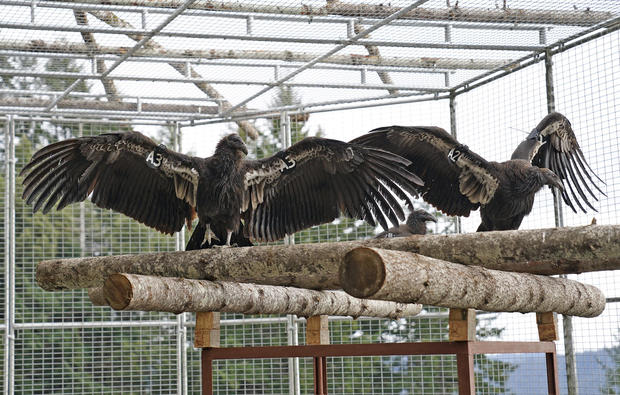those in danger of extinction California condor It took to the skies again over the redwood forests of the state’s north coast Tuesday for the first time in more than a century.
Two captive-bred birds were released from a pen in Redwood National Park, about an hour’s drive south of the Oregon border, as part of a project to restore giant vultures to their historic habitat in the Northwest. from Pacific.
The two male condors were moved to the staging area in the late morning and a remote controlled gate was opened. After a few minutes of cautiously peering into the opening, the birds entered through the opening one by one, spread their gigantic wings, and took off.
“They just jumped up and flew off into the distance,” Tiana Williams-Claussen, wildlife director for the region’s Yurok tribe, said in a webcast.
Condors were last seen in the park area around 1892, officials said. The California condor is the largest native North American bird, with a wingspan of nearly 10 feet. The scavenger was once widespread, but had virtually disappeared by the 1970s due to poaching, lead poisoning from eating animals shot by hunters, and habitat destruction.
/AP
The birds can live 60 years and fly great distances in search of carrion, so their range could extend to several states.
Federal and local fish and wildlife agencies are involved in the restoration project spearheaded by the Yurok tribe, which has traditionally considered the California condor a sacred animal and has been working for years to return the species to the tribe’s ancestral territory. .
“For countless generations, the Yurok people have upheld the sacred responsibility of maintaining balance in the natural world. The reintroduction of the condor is a real manifestation of our cultural commitment to restore and protect the planet for future generations,” said the president of the tribe, Joseph L. James. he said in a statement.
Two more condors were scheduled to be released later, after biologists determined the two birds that took to the skies Tuesday displayed appropriate behavior, officials said.
The condors, including one female and three males, are between 2 and 4 years old. Two were born at the Oregon Zoo and two at the Peregrine Fund’s World Center for Birds of Prey in Idaho.
In the early 1980s, the 22 condors remaining in the wild were trapped and brought into a captive breeding program that began releasing the giant vultures into the Los Padres National Forest of southern California in 1992.
That flock has been expanding its range, while other condors now occupy parts of the central coast of California, Arizona, Utah, and Baja California, Mexico. The total population now stands at more than 500 captive and free birds.
Two years ago, California condors were sighted in Sequoia National Park in California’s Sierra Nevada for the first time in nearly 50 years.
However, that same year, a dozen adults and two chicks were killed when a wildfire started by an arsonist devastated their territory off the coast of Big Sur.
How hunters can help bring back the California condor
Chris Parish, director of global conservation for the Peregrine Fund, he told CBS News last year that 54% of the condor deaths they monitor are due to lead poisoning.
Lead is a dangerous neurotoxin; it’s also what most ammunition is made of. The birds are dying of bullets. They don’t shoot at them; they are literally eating lead.
“Wild scavengers that are obligate, like the condor, only consume things that are already dead,” Parish said.
When hunters kill an animal, such as a deer, they often leave behind some remains. But they may be unintentionally leaving behind small bits of lead, which end up on condors as they pass by to enjoy a meal.
“Some of those little fragments that break off from those bullets that we’ve used for 100 years can poison wildlife,” Parish said.
Parish is on a mission to convince hunters to hunt with lead-free ammunition, like copper bullets, by holding demonstrations across the country. It’s a world he knows well: “I’m kind of a redneck hunter-biologist, and these hunters are my people.”

